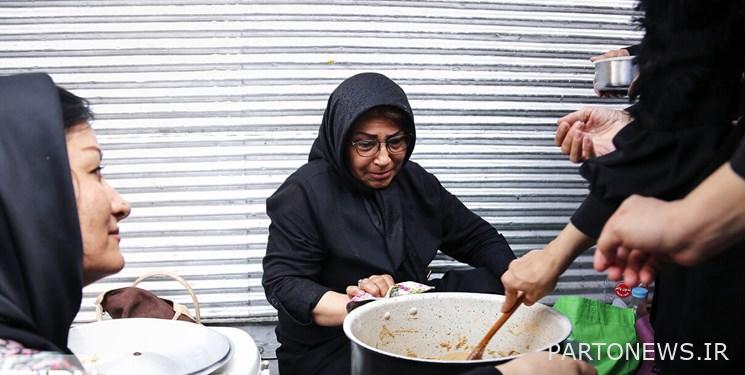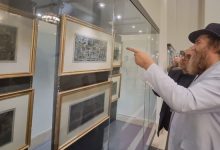Why is Tasua a halwapazan?/ Crossroads of Globandak; The sweetest street in Iran

group Society; Naima Javidi: Tasuai Hosseini, among all nazri cooks, cooking a nazri is more prosperous; Confectioners This tradition is more common among Azeri-speakers and northerners, but the atmosphere of Tasuai in the capital is not without the aroma of roasted flour and the sweet nectar of halva. Various centers have halvapazans, but it is done in a limited way. For example, in Tehran Pars, Imam Bazar Mosque, Selsbeil Street and Tarasht, there are families, residents of an alley, or Hosseini mourners of a mosque or Hosseinieh, who gather around and cook halva.
However, the procession of Hosseini mourners on the day of Tasua to cook halwa at Golubandak intersection is very complete and large, so much so that besides the devotees of Ahl al-Bayt (pbuh) and the needy, religious tourists also come to this street. However, this folk tradition, which is not more than 30 years old, is not as well known as it is. If you want to experience a different and memorable Tasua Hosseini tomorrow from 8 am to around 1 pm you can reach this street. But what happened that Golubandak intersection has become Tehran’s halvai intersection, why halva is the main offering of Tasu’a, Pirgholam Hosseini explains.

Folk tales from a Nazri
The main hangout of halva chefs is in Golubandak, in the area of Shahid Chaterchi alley, Hosseinieh Karbalai. But what is the story of this vow and what happened that Hosseini Tasuai was opened to devotees to this street? Those who participate in this vow-making, say about what they have heard that there was a house in front of Karbalai’s Hosseiniyeh where Sidi Salamand lived. It had a pulpit. He was praying, but as soon as he died, the people of the house left the old equipment outside the house, and as soon as they returned, they saw that the pulpit had returned to its place. Therefore, they donated the equipment and continued making halvapazan inside the house, but there was a fire and about 30 years ago, the homemade vow was taken to the street and became more public. The narrative of the natives and residents of the neighborhood is something else: Seyyed was a fasting person. He used to cook tasua halva himself, he didn’t advise anyone, but people would go and help themselves. Once several women were careless, the fire of the stove spread in the house and a fire started. After that, halvapazaan was held in the alley, that is, the alley of martyr Amirchatrchi. Over time, eager and needy people took vows and intentions that if they were in need next year, they would cook and bring halva themselves or come here and cook halva.

Do not add superstitions
In the narration of the natives of the neighborhood, there is no news about the narration of the pulpit or that each person should take a blessing from 7 pots of halvah and take it to have a need. They are not happy about these additions to folk rituals. “Hasan Mahiri” says: “Some of them add these clauses and notes to the vows and dilute the spirit of spirituality. Let’s think for a minute, does it mean that if someone touches his chest from two, three, or three pots of offerings and blessings of Ahl al-Bayt (PBUH), it must be seven pieces of halvah? What is this? Most of the crowding and crowding of the street, which sometimes makes it difficult for people who have come to pay their vows, is because of this wrong way of thinking. The Nazri of Ahl al-Bayt (AS) is also blessed. Many times I have seen distinguished people who are in control of their ego. They take a small offering and blessing from a pot and take it away.”

A street of watching and mourning
Those who bring themselves Tasuai Hosseini to Golubandak will fall in love with the pleasant aroma that gives this street a unique atmosphere. Abu Saeed, which is located near Moniriyeh and the area of Globandak crossroads. It has a different mood on normal days. The stock exchange is selling technical parts and sportswear. Tasua, but the whole street is covered in black by Amir Alqamah. Many people reach the pulpit of famous preachers of the city, including Sheikh “Hussein Ansarian” in Hosseiniyeh of Hamadanis and Karbalais. Mourning in the Hosseiniyeh of the Arabs or those of Karbala is one of the pure and different feelings of mourning in the Arabic way. Azeri speakers do not go empty-handed here. Two large boards are located on the corner of the street, which give a special atmosphere to the passage. There is also a Salvati station with interesting offerings. Distribution of bread, cheese and vegetables. bread and milk Potatoes and boiled eggs, bread and dates, and…

Reception of Imam Hossein’s guests
Some people don’t come here for vows, intentions, and needs to buy halva, and if they need it, they bring a picnic and cooking utensils themselves next year. These are the ones whose hand-baked halvah is famous among friends and acquaintances. Hossein passers-by would like to taste a little of the halwa they cook for the beneficence of Hosseini mourners and to express their devotion to the Ahl al-Bayt family. This group either brings cooked and packaged halvah from home or they spread it right here on the street, and those who are interested can help by mixing halvah or preparing nectar. Some cook simple halwa; The flour, which has been fried and changed its color and turned brown, is prepared with a little nectar of water and sugar. Some add milk and saffron and it gets a better color and glaze and taste. There are people of taste and need who cook halva in their own city. From Shirazi bowl halvah to dry Azerbaijani halvah and northern rice halvah. However, saffron and rose water halva and grape juice halva are fragrant, tasty and more popular than others.

They agree with us, Kariman
Among the passers-by of Tasouai Street, there are people who have either happened to come across this street or have heard about it and came to bring themselves to this fat and sweet gathering. However, when their feet open to the street and they sit at the tables, their opinion changes. No one comes here to say that they have better cooking or to eat tastier halvah. The sound of mournful wails at the foot of every offering table or the mournful chants of mourners who bring themselves to people’s houses to collect offerings or hosseiniyehs for mourning gives a sad atmosphere to the street. Some people put their sick child, spouse or loved one on a wheelchair and bring them along. Some people bring a small photo of a loved one who was alive until recently, but this year his place is empty and his hand is short from the world, and they cook halwa for Hazrat Saqqa for the intention of the dead.

A string that cannot be broken
“Manijeh Rahmati” is the mother of a daughter suffering from a nervous disorder and says: “My daughter likes this ceremony very much. We come here every year. An offering is made and we leave. With the blessing of people’s devotion to Ahl al-Bayt (AS) who cook Nazri with all their love and being, on the other hand, from the side of Hazrat Abul Fazl (AS), who are the Most Merciful and Merciful, no one goes empty-handed. If you go to the table of each of these offering makers and ask them questions, you will see that they were in need a year or so ago and now they are making offerings. Some of them have finished their vows, but they still come out of devotion and make a pot of halvah. They don’t want to cut the bond of love between them.” Rahmati is a mother who does not see her daughter’s pain as a problem. His mature and pleasant look has caused him to say pure words that touch people’s hearts. What a string of sweets, what a pleasant taste it is to cook halva for someone whose name and amen have become the credit of the needy.

Do not be a servant here, you are a loser!
Those who are interested in cooking Nazri, but for any reason, including finances, may not have the conditions to spread a table, their names will be registered among the servants of Ahl al-Bayt (A.S.) on Golubandak Street, if they are willing and willing. “Reza Mardani” from the Hosseini Youth says: “To be honest, I had financial problems two years ago for some reason. My heart broke, but as soon as my husband and I came to this street, we saw women sitting on the corner of the sidewalk, cleaning vegetables in front of a delegation and Hosseinieh. Some made bread, cheese and vegetable bites. Part of the vegetables was related to Hosseinieh’s lunch, which Tasua cooks broth. It was a good mood. It was a very good opportunity for us, who were empty-handed and full of sadness. Now, thank God, my hand reaches my pocket and oh! If they accept, I will add salt to this offering.”

We are restless for you, Husayn (pbuh)!
The issue is not always financial. Many people like to work for Ahl al-Bayt (a.s.), and as the old saying goes, they consider it their body’s zakat. On the other hand, with their help, they would like the vow maker to be less tired so that with the encouragement of the same help, he will come next year and fulfill his vow. That is why, as soon as Bani strikes a match under the offering pot and pours the flour into the container, some people line up to take the whisk from his hand and stir. They ask God for their needs. Some women also give a good atmosphere to this gathering by reciting Ashura pilgrimage, tawasl prayers and hadiths, and those who make offerings are more blessed by the memory of God. The owner of the Nazri pot pours halva either in the dishes he brought or the dishes brought by the people. Nazri baking continues until noon. People don’t just take the aroma and taste of halva with them, the empathy and sense of religious attachment that they experience every year under the same pretext and blessings keeps their hearts restless from this Muharram to the next Muharram. The love of Imam Hossein (a.s.) and Qamar Bani Hashem (a.s.) makes this street acquire a different atmosphere and meaning for them; A street where people sympathize sweetly for Ahl al-Bayt (AS).

Why is Tasua a halvapazan?
Around 11:00 am to 1:00 pm, the group of Shah Hossein Goyan Azari speakers in Waliasr street, Monirieh intersection, strengthens the spiritual mood of the mourners with the poignant tunes of Turkish rosaries and their special way of mourning. Some people use symbolic swords and sticks and raise and lower the whisper of blood lust for the blood of the oppressed martyrs of Karbala in the minds of the people and refresh their pain. Do you know, my daughter, why Tasua, people cook halwa, not on Ashura, not on the third day of the Imam, and not at any other time?! Imam Hussain (a.s.) became very angry with the martyrdom of his brother Hazrat Abbas (a.s.), his anger reached the highest level. Imam Hussain (a.s.) was there when he imagined the burnt tents after Alamdar. It was there that he himself was martyred even though he was still at the time of death. We, the Azeri speakers, are making halwa pazan tasua to express our condolences to Mullah Hussain (a.s.) in this great heat and show our respect before the time of his martyrdom. We want to place ourselves in the eyes of Imam Hussain (AS), God willing, one day in their hearts.” Here, sugar halwa, the words of the mourners of Imam Hossein (a.s.) who were burned in the chest, sweetens the soul of a person in Halvapazan street of Iran…
/end of message
You can edit this article
Suggest this article for the first page

